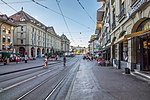Burgerbibliothek of Berne

The Burgerbibliothek of Berne (German: Burgerbibliothek Bern) is a public library located at Münstergasse 63 in Berne, Switzerland. The origins of this institution can be traced back to the Reformation. Until 1951 it belonged jointly to the city and the University of Bern, and was supported by the Canton of Berne and by the Community of Burghers of Berne. The collection of the library includes the illustrated late mediaeval historical chronicle Berner Chronik written by Diebold Schilling the Elder, Liber ad honorem Augusti. It contains about 30 000 pictorial documents about Berne and about 1 000 precious codices, some of them from the late antiquity. The library includes collections inherited from the following collectors: Eduard Bähler Philipp Emanuel von Fellenberg Jeremias Gotthelf Johann Rudolf Gruner Kurt Guggisberg (part of inheritance) Albrecht von Haller Karl Howald Ernst Kreidolf Rudolf Münger Rudolf Abraham von Schiferli Gottlieb Samuel Studer Rudolf von Tavel Gertrud Züricher
Excerpt from the Wikipedia article Burgerbibliothek of Berne (License: CC BY-SA 3.0, Authors, Images).Burgerbibliothek of Berne
Bibliotheksgässchen, Bern
Geographical coordinates (GPS) Address Nearby Places Show on map
Geographical coordinates (GPS)
| Latitude | Longitude |
|---|---|
| N 46.9473 ° | E 7.4483 ° |
Address
Bibliotheksgässchen
3011 Bern (Stadtteil I)
Bern, Switzerland
Open on Google Maps








